A Literature Review on Innovation, User Experience and Design
VerifiedAdded on 2023/06/03
|11
|3066
|406
Literature Review
AI Summary
This literature review examines the role of innovation in supporting sustainable business operations in international markets, focusing on how understanding customer needs facilitates innovation. It discusses the importance of user experience, drawing on ISO standards and differentiating it from consumer experience. The review highlights how continuous quality management and customer satisfaction drive organizational changes and innovation. It emphasizes the significance of identifying target users, conducting market surveys, and analyzing competitor developments to gain a competitive advantage. Key elements of change, such as sustainability and internal/external competencies, are explored, along with the role of workplace culture and management control. The review also covers the design thinking process, emphasizing empathy, ideation, prototyping, and problem-solving. It differentiates between exploratory and adaptive modifications in product and service development, technological aspects, and the importance of customer satisfaction. The review concludes that continuous innovation in processes and offerings, based on market trends and consumer behaviors, is essential for organizational sustenance, while acknowledging the cost constraints associated with innovation processes. Desklib offers a variety of solved assignments and resources to aid students in similar topics.

Running head: INNOVATION
INNOVATION
Name of the student
Name of the university
Author note
INNOVATION
Name of the student
Name of the university
Author note
Paraphrase This Document
Need a fresh take? Get an instant paraphrase of this document with our AI Paraphraser
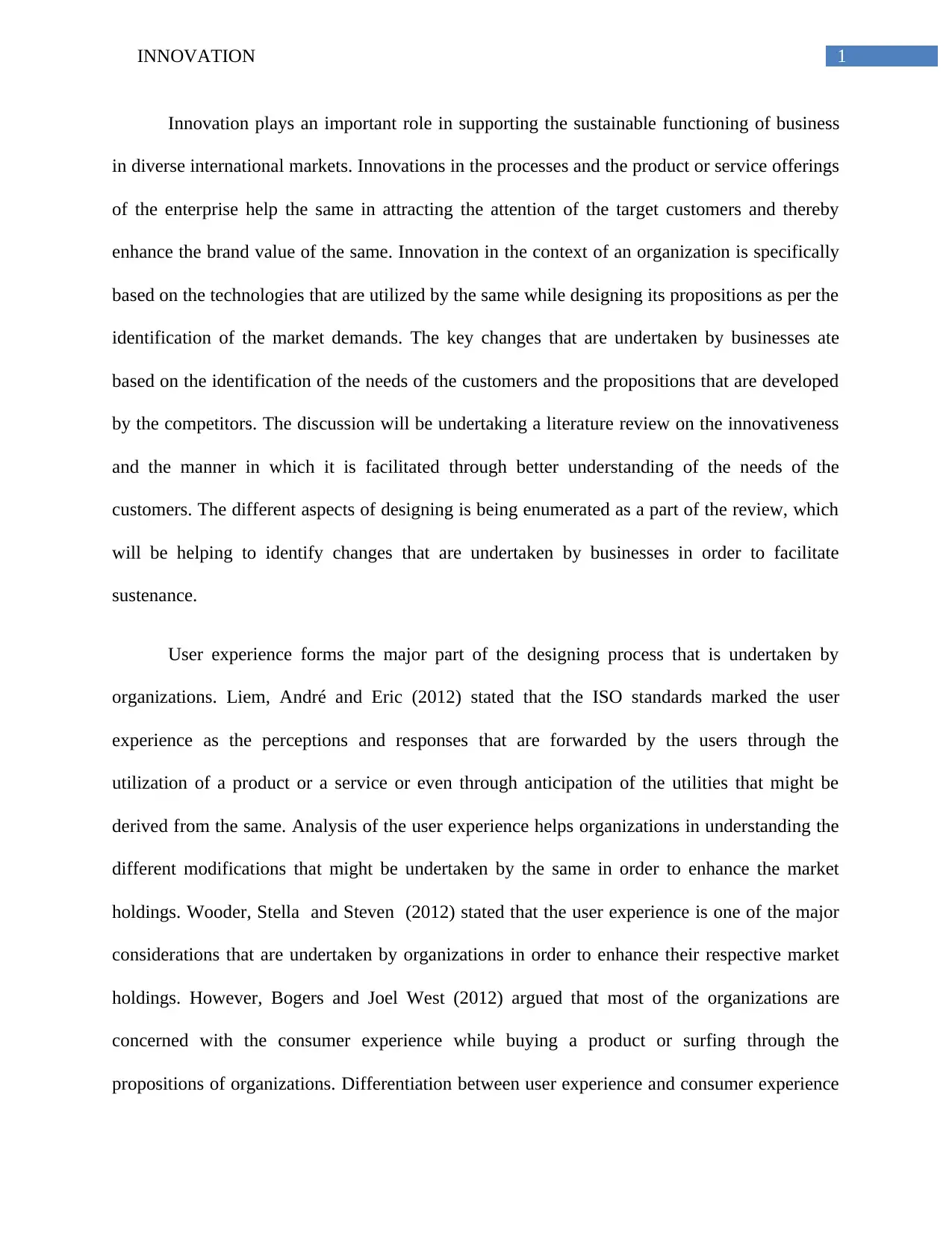
1INNOVATION
Innovation plays an important role in supporting the sustainable functioning of business
in diverse international markets. Innovations in the processes and the product or service offerings
of the enterprise help the same in attracting the attention of the target customers and thereby
enhance the brand value of the same. Innovation in the context of an organization is specifically
based on the technologies that are utilized by the same while designing its propositions as per the
identification of the market demands. The key changes that are undertaken by businesses ate
based on the identification of the needs of the customers and the propositions that are developed
by the competitors. The discussion will be undertaking a literature review on the innovativeness
and the manner in which it is facilitated through better understanding of the needs of the
customers. The different aspects of designing is being enumerated as a part of the review, which
will be helping to identify changes that are undertaken by businesses in order to facilitate
sustenance.
User experience forms the major part of the designing process that is undertaken by
organizations. Liem, André and Eric (2012) stated that the ISO standards marked the user
experience as the perceptions and responses that are forwarded by the users through the
utilization of a product or a service or even through anticipation of the utilities that might be
derived from the same. Analysis of the user experience helps organizations in understanding the
different modifications that might be undertaken by the same in order to enhance the market
holdings. Wooder, Stella and Steven (2012) stated that the user experience is one of the major
considerations that are undertaken by organizations in order to enhance their respective market
holdings. However, Bogers and Joel West (2012) argued that most of the organizations are
concerned with the consumer experience while buying a product or surfing through the
propositions of organizations. Differentiation between user experience and consumer experience
Innovation plays an important role in supporting the sustainable functioning of business
in diverse international markets. Innovations in the processes and the product or service offerings
of the enterprise help the same in attracting the attention of the target customers and thereby
enhance the brand value of the same. Innovation in the context of an organization is specifically
based on the technologies that are utilized by the same while designing its propositions as per the
identification of the market demands. The key changes that are undertaken by businesses ate
based on the identification of the needs of the customers and the propositions that are developed
by the competitors. The discussion will be undertaking a literature review on the innovativeness
and the manner in which it is facilitated through better understanding of the needs of the
customers. The different aspects of designing is being enumerated as a part of the review, which
will be helping to identify changes that are undertaken by businesses in order to facilitate
sustenance.
User experience forms the major part of the designing process that is undertaken by
organizations. Liem, André and Eric (2012) stated that the ISO standards marked the user
experience as the perceptions and responses that are forwarded by the users through the
utilization of a product or a service or even through anticipation of the utilities that might be
derived from the same. Analysis of the user experience helps organizations in understanding the
different modifications that might be undertaken by the same in order to enhance the market
holdings. Wooder, Stella and Steven (2012) stated that the user experience is one of the major
considerations that are undertaken by organizations in order to enhance their respective market
holdings. However, Bogers and Joel West (2012) argued that most of the organizations are
concerned with the consumer experience while buying a product or surfing through the
propositions of organizations. Differentiation between user experience and consumer experience
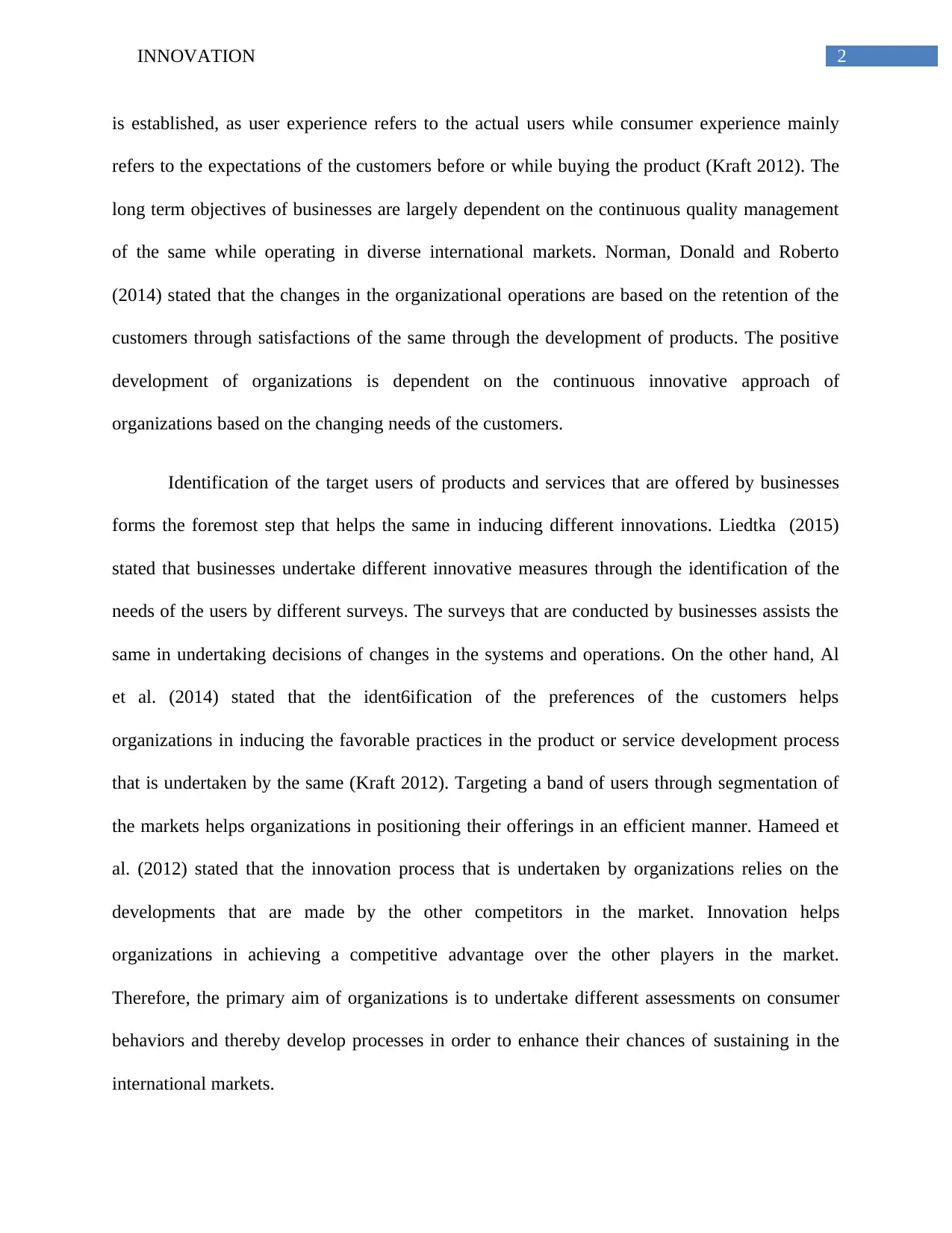
2INNOVATION
is established, as user experience refers to the actual users while consumer experience mainly
refers to the expectations of the customers before or while buying the product (Kraft 2012). The
long term objectives of businesses are largely dependent on the continuous quality management
of the same while operating in diverse international markets. Norman, Donald and Roberto
(2014) stated that the changes in the organizational operations are based on the retention of the
customers through satisfactions of the same through the development of products. The positive
development of organizations is dependent on the continuous innovative approach of
organizations based on the changing needs of the customers.
Identification of the target users of products and services that are offered by businesses
forms the foremost step that helps the same in inducing different innovations. Liedtka (2015)
stated that businesses undertake different innovative measures through the identification of the
needs of the users by different surveys. The surveys that are conducted by businesses assists the
same in undertaking decisions of changes in the systems and operations. On the other hand, Al
et al. (2014) stated that the ident6ification of the preferences of the customers helps
organizations in inducing the favorable practices in the product or service development process
that is undertaken by the same (Kraft 2012). Targeting a band of users through segmentation of
the markets helps organizations in positioning their offerings in an efficient manner. Hameed et
al. (2012) stated that the innovation process that is undertaken by organizations relies on the
developments that are made by the other competitors in the market. Innovation helps
organizations in achieving a competitive advantage over the other players in the market.
Therefore, the primary aim of organizations is to undertake different assessments on consumer
behaviors and thereby develop processes in order to enhance their chances of sustaining in the
international markets.
is established, as user experience refers to the actual users while consumer experience mainly
refers to the expectations of the customers before or while buying the product (Kraft 2012). The
long term objectives of businesses are largely dependent on the continuous quality management
of the same while operating in diverse international markets. Norman, Donald and Roberto
(2014) stated that the changes in the organizational operations are based on the retention of the
customers through satisfactions of the same through the development of products. The positive
development of organizations is dependent on the continuous innovative approach of
organizations based on the changing needs of the customers.
Identification of the target users of products and services that are offered by businesses
forms the foremost step that helps the same in inducing different innovations. Liedtka (2015)
stated that businesses undertake different innovative measures through the identification of the
needs of the users by different surveys. The surveys that are conducted by businesses assists the
same in undertaking decisions of changes in the systems and operations. On the other hand, Al
et al. (2014) stated that the ident6ification of the preferences of the customers helps
organizations in inducing the favorable practices in the product or service development process
that is undertaken by the same (Kraft 2012). Targeting a band of users through segmentation of
the markets helps organizations in positioning their offerings in an efficient manner. Hameed et
al. (2012) stated that the innovation process that is undertaken by organizations relies on the
developments that are made by the other competitors in the market. Innovation helps
organizations in achieving a competitive advantage over the other players in the market.
Therefore, the primary aim of organizations is to undertake different assessments on consumer
behaviors and thereby develop processes in order to enhance their chances of sustaining in the
international markets.
⊘ This is a preview!⊘
Do you want full access?
Subscribe today to unlock all pages.

Trusted by 1+ million students worldwide
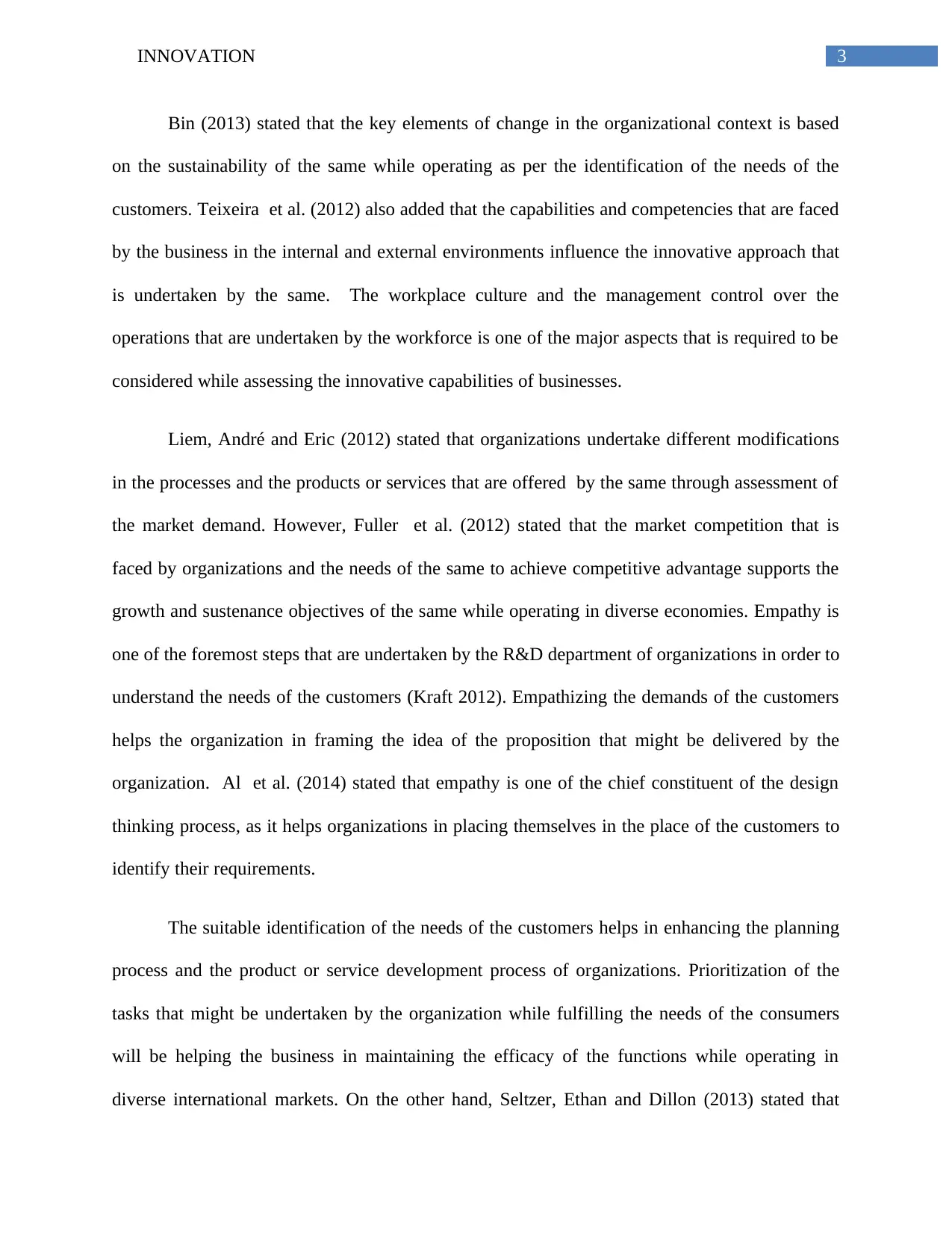
3INNOVATION
Bin (2013) stated that the key elements of change in the organizational context is based
on the sustainability of the same while operating as per the identification of the needs of the
customers. Teixeira et al. (2012) also added that the capabilities and competencies that are faced
by the business in the internal and external environments influence the innovative approach that
is undertaken by the same. The workplace culture and the management control over the
operations that are undertaken by the workforce is one of the major aspects that is required to be
considered while assessing the innovative capabilities of businesses.
Liem, André and Eric (2012) stated that organizations undertake different modifications
in the processes and the products or services that are offered by the same through assessment of
the market demand. However, Fuller et al. (2012) stated that the market competition that is
faced by organizations and the needs of the same to achieve competitive advantage supports the
growth and sustenance objectives of the same while operating in diverse economies. Empathy is
one of the foremost steps that are undertaken by the R&D department of organizations in order to
understand the needs of the customers (Kraft 2012). Empathizing the demands of the customers
helps the organization in framing the idea of the proposition that might be delivered by the
organization. Al et al. (2014) stated that empathy is one of the chief constituent of the design
thinking process, as it helps organizations in placing themselves in the place of the customers to
identify their requirements.
The suitable identification of the needs of the customers helps in enhancing the planning
process and the product or service development process of organizations. Prioritization of the
tasks that might be undertaken by the organization while fulfilling the needs of the consumers
will be helping the business in maintaining the efficacy of the functions while operating in
diverse international markets. On the other hand, Seltzer, Ethan and Dillon (2013) stated that
Bin (2013) stated that the key elements of change in the organizational context is based
on the sustainability of the same while operating as per the identification of the needs of the
customers. Teixeira et al. (2012) also added that the capabilities and competencies that are faced
by the business in the internal and external environments influence the innovative approach that
is undertaken by the same. The workplace culture and the management control over the
operations that are undertaken by the workforce is one of the major aspects that is required to be
considered while assessing the innovative capabilities of businesses.
Liem, André and Eric (2012) stated that organizations undertake different modifications
in the processes and the products or services that are offered by the same through assessment of
the market demand. However, Fuller et al. (2012) stated that the market competition that is
faced by organizations and the needs of the same to achieve competitive advantage supports the
growth and sustenance objectives of the same while operating in diverse economies. Empathy is
one of the foremost steps that are undertaken by the R&D department of organizations in order to
understand the needs of the customers (Kraft 2012). Empathizing the demands of the customers
helps the organization in framing the idea of the proposition that might be delivered by the
organization. Al et al. (2014) stated that empathy is one of the chief constituent of the design
thinking process, as it helps organizations in placing themselves in the place of the customers to
identify their requirements.
The suitable identification of the needs of the customers helps in enhancing the planning
process and the product or service development process of organizations. Prioritization of the
tasks that might be undertaken by the organization while fulfilling the needs of the consumers
will be helping the business in maintaining the efficacy of the functions while operating in
diverse international markets. On the other hand, Seltzer, Ethan and Dillon (2013) stated that
Paraphrase This Document
Need a fresh take? Get an instant paraphrase of this document with our AI Paraphraser
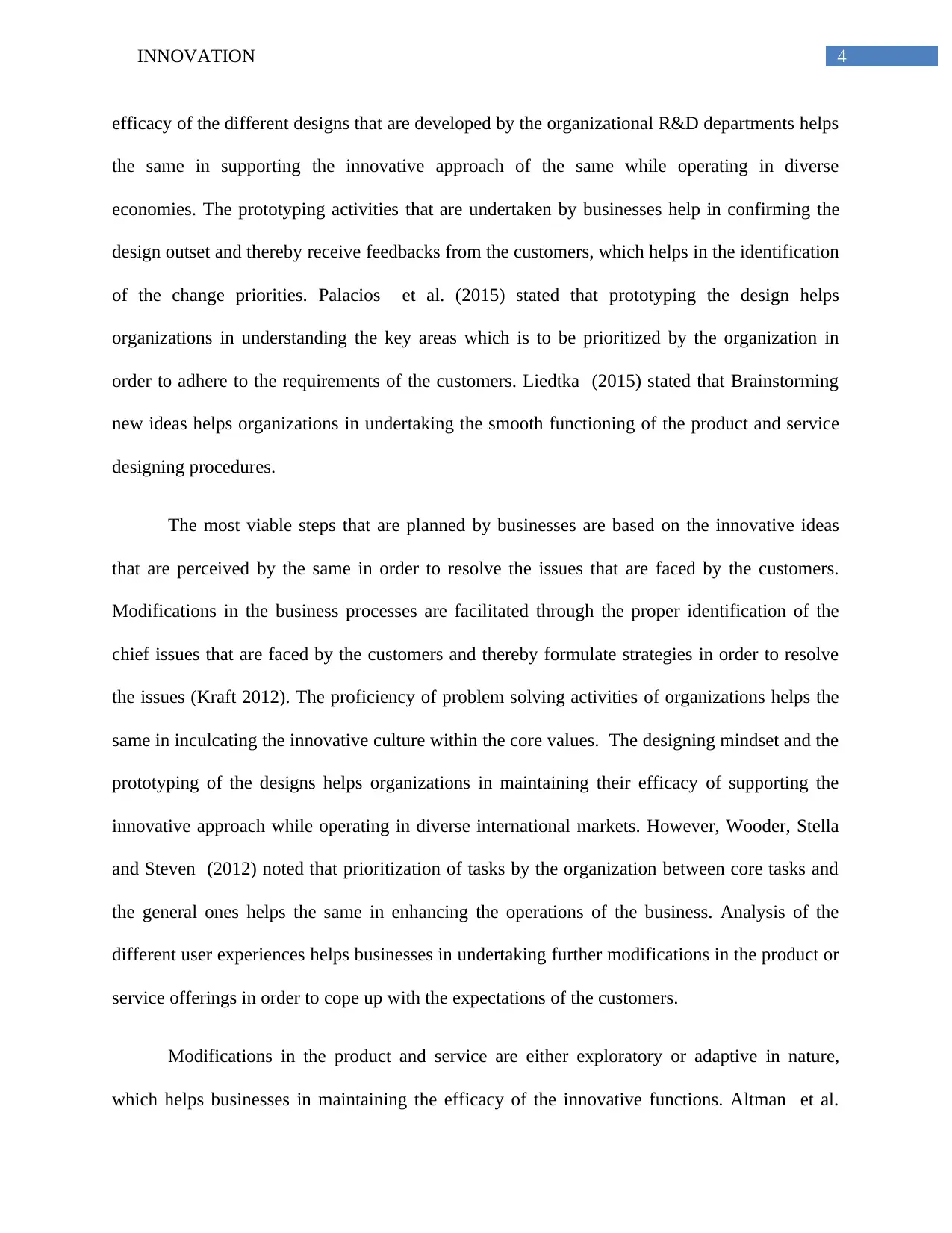
4INNOVATION
efficacy of the different designs that are developed by the organizational R&D departments helps
the same in supporting the innovative approach of the same while operating in diverse
economies. The prototyping activities that are undertaken by businesses help in confirming the
design outset and thereby receive feedbacks from the customers, which helps in the identification
of the change priorities. Palacios et al. (2015) stated that prototyping the design helps
organizations in understanding the key areas which is to be prioritized by the organization in
order to adhere to the requirements of the customers. Liedtka (2015) stated that Brainstorming
new ideas helps organizations in undertaking the smooth functioning of the product and service
designing procedures.
The most viable steps that are planned by businesses are based on the innovative ideas
that are perceived by the same in order to resolve the issues that are faced by the customers.
Modifications in the business processes are facilitated through the proper identification of the
chief issues that are faced by the customers and thereby formulate strategies in order to resolve
the issues (Kraft 2012). The proficiency of problem solving activities of organizations helps the
same in inculcating the innovative culture within the core values. The designing mindset and the
prototyping of the designs helps organizations in maintaining their efficacy of supporting the
innovative approach while operating in diverse international markets. However, Wooder, Stella
and Steven (2012) noted that prioritization of tasks by the organization between core tasks and
the general ones helps the same in enhancing the operations of the business. Analysis of the
different user experiences helps businesses in undertaking further modifications in the product or
service offerings in order to cope up with the expectations of the customers.
Modifications in the product and service are either exploratory or adaptive in nature,
which helps businesses in maintaining the efficacy of the innovative functions. Altman et al.
efficacy of the different designs that are developed by the organizational R&D departments helps
the same in supporting the innovative approach of the same while operating in diverse
economies. The prototyping activities that are undertaken by businesses help in confirming the
design outset and thereby receive feedbacks from the customers, which helps in the identification
of the change priorities. Palacios et al. (2015) stated that prototyping the design helps
organizations in understanding the key areas which is to be prioritized by the organization in
order to adhere to the requirements of the customers. Liedtka (2015) stated that Brainstorming
new ideas helps organizations in undertaking the smooth functioning of the product and service
designing procedures.
The most viable steps that are planned by businesses are based on the innovative ideas
that are perceived by the same in order to resolve the issues that are faced by the customers.
Modifications in the business processes are facilitated through the proper identification of the
chief issues that are faced by the customers and thereby formulate strategies in order to resolve
the issues (Kraft 2012). The proficiency of problem solving activities of organizations helps the
same in inculcating the innovative culture within the core values. The designing mindset and the
prototyping of the designs helps organizations in maintaining their efficacy of supporting the
innovative approach while operating in diverse international markets. However, Wooder, Stella
and Steven (2012) noted that prioritization of tasks by the organization between core tasks and
the general ones helps the same in enhancing the operations of the business. Analysis of the
different user experiences helps businesses in undertaking further modifications in the product or
service offerings in order to cope up with the expectations of the customers.
Modifications in the product and service are either exploratory or adaptive in nature,
which helps businesses in maintaining the efficacy of the innovative functions. Altman et al.
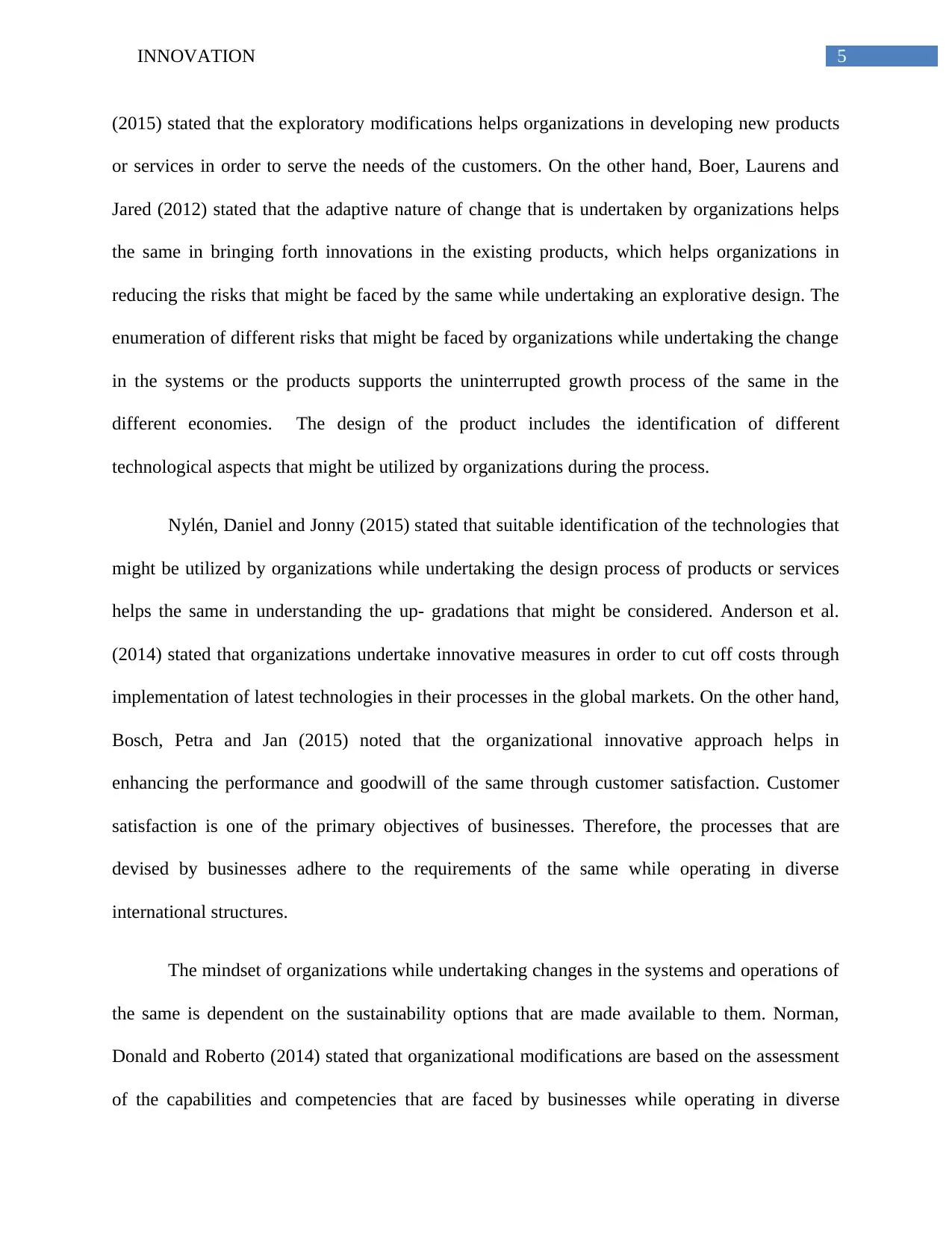
5INNOVATION
(2015) stated that the exploratory modifications helps organizations in developing new products
or services in order to serve the needs of the customers. On the other hand, Boer, Laurens and
Jared (2012) stated that the adaptive nature of change that is undertaken by organizations helps
the same in bringing forth innovations in the existing products, which helps organizations in
reducing the risks that might be faced by the same while undertaking an explorative design. The
enumeration of different risks that might be faced by organizations while undertaking the change
in the systems or the products supports the uninterrupted growth process of the same in the
different economies. The design of the product includes the identification of different
technological aspects that might be utilized by organizations during the process.
Nylén, Daniel and Jonny (2015) stated that suitable identification of the technologies that
might be utilized by organizations while undertaking the design process of products or services
helps the same in understanding the up- gradations that might be considered. Anderson et al.
(2014) stated that organizations undertake innovative measures in order to cut off costs through
implementation of latest technologies in their processes in the global markets. On the other hand,
Bosch, Petra and Jan (2015) noted that the organizational innovative approach helps in
enhancing the performance and goodwill of the same through customer satisfaction. Customer
satisfaction is one of the primary objectives of businesses. Therefore, the processes that are
devised by businesses adhere to the requirements of the same while operating in diverse
international structures.
The mindset of organizations while undertaking changes in the systems and operations of
the same is dependent on the sustainability options that are made available to them. Norman,
Donald and Roberto (2014) stated that organizational modifications are based on the assessment
of the capabilities and competencies that are faced by businesses while operating in diverse
(2015) stated that the exploratory modifications helps organizations in developing new products
or services in order to serve the needs of the customers. On the other hand, Boer, Laurens and
Jared (2012) stated that the adaptive nature of change that is undertaken by organizations helps
the same in bringing forth innovations in the existing products, which helps organizations in
reducing the risks that might be faced by the same while undertaking an explorative design. The
enumeration of different risks that might be faced by organizations while undertaking the change
in the systems or the products supports the uninterrupted growth process of the same in the
different economies. The design of the product includes the identification of different
technological aspects that might be utilized by organizations during the process.
Nylén, Daniel and Jonny (2015) stated that suitable identification of the technologies that
might be utilized by organizations while undertaking the design process of products or services
helps the same in understanding the up- gradations that might be considered. Anderson et al.
(2014) stated that organizations undertake innovative measures in order to cut off costs through
implementation of latest technologies in their processes in the global markets. On the other hand,
Bosch, Petra and Jan (2015) noted that the organizational innovative approach helps in
enhancing the performance and goodwill of the same through customer satisfaction. Customer
satisfaction is one of the primary objectives of businesses. Therefore, the processes that are
devised by businesses adhere to the requirements of the same while operating in diverse
international structures.
The mindset of organizations while undertaking changes in the systems and operations of
the same is dependent on the sustainability options that are made available to them. Norman,
Donald and Roberto (2014) stated that organizational modifications are based on the assessment
of the capabilities and competencies that are faced by businesses while operating in diverse
⊘ This is a preview!⊘
Do you want full access?
Subscribe today to unlock all pages.

Trusted by 1+ million students worldwide
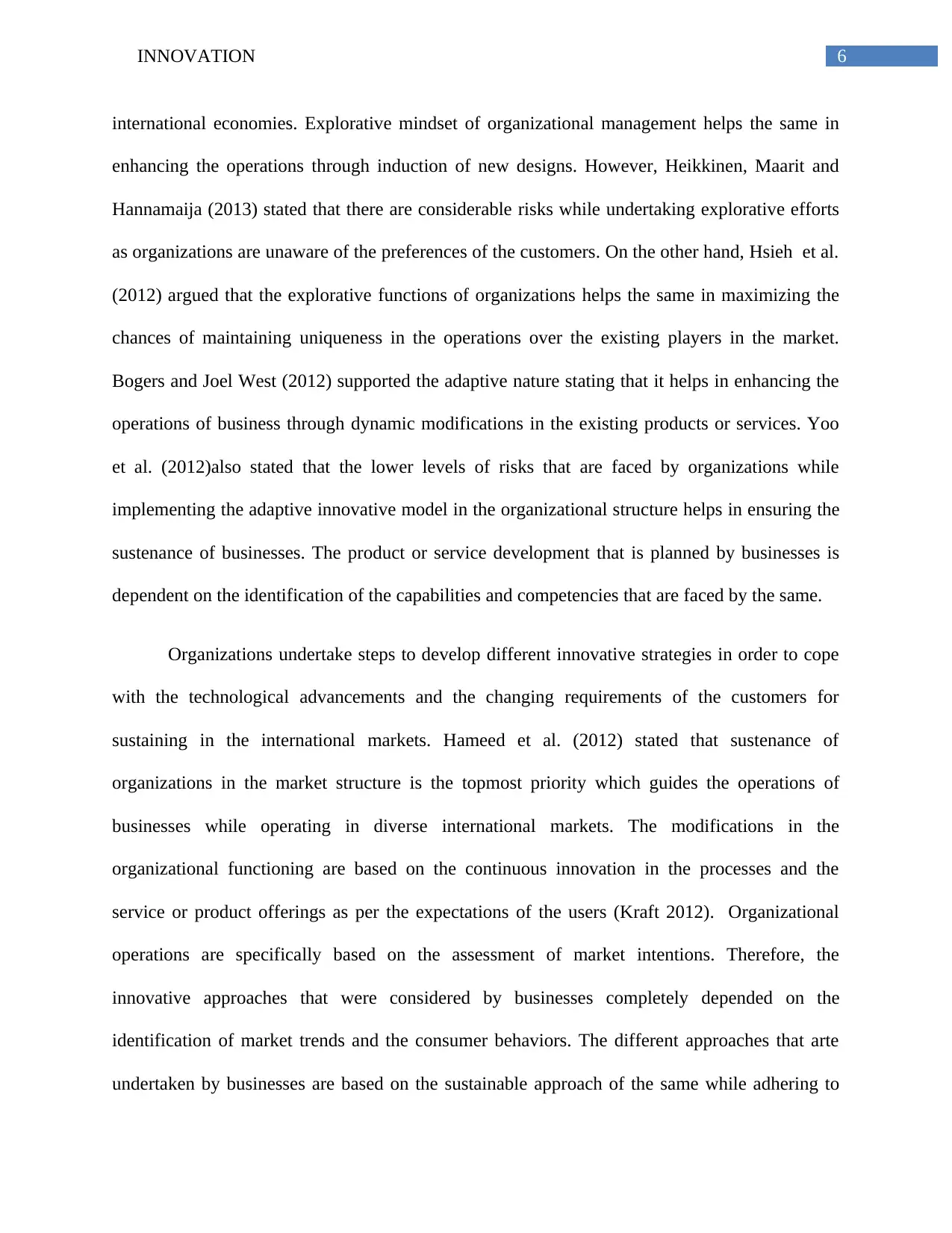
6INNOVATION
international economies. Explorative mindset of organizational management helps the same in
enhancing the operations through induction of new designs. However, Heikkinen, Maarit and
Hannamaija (2013) stated that there are considerable risks while undertaking explorative efforts
as organizations are unaware of the preferences of the customers. On the other hand, Hsieh et al.
(2012) argued that the explorative functions of organizations helps the same in maximizing the
chances of maintaining uniqueness in the operations over the existing players in the market.
Bogers and Joel West (2012) supported the adaptive nature stating that it helps in enhancing the
operations of business through dynamic modifications in the existing products or services. Yoo
et al. (2012)also stated that the lower levels of risks that are faced by organizations while
implementing the adaptive innovative model in the organizational structure helps in ensuring the
sustenance of businesses. The product or service development that is planned by businesses is
dependent on the identification of the capabilities and competencies that are faced by the same.
Organizations undertake steps to develop different innovative strategies in order to cope
with the technological advancements and the changing requirements of the customers for
sustaining in the international markets. Hameed et al. (2012) stated that sustenance of
organizations in the market structure is the topmost priority which guides the operations of
businesses while operating in diverse international markets. The modifications in the
organizational functioning are based on the continuous innovation in the processes and the
service or product offerings as per the expectations of the users (Kraft 2012). Organizational
operations are specifically based on the assessment of market intentions. Therefore, the
innovative approaches that were considered by businesses completely depended on the
identification of market trends and the consumer behaviors. The different approaches that arte
undertaken by businesses are based on the sustainable approach of the same while adhering to
international economies. Explorative mindset of organizational management helps the same in
enhancing the operations through induction of new designs. However, Heikkinen, Maarit and
Hannamaija (2013) stated that there are considerable risks while undertaking explorative efforts
as organizations are unaware of the preferences of the customers. On the other hand, Hsieh et al.
(2012) argued that the explorative functions of organizations helps the same in maximizing the
chances of maintaining uniqueness in the operations over the existing players in the market.
Bogers and Joel West (2012) supported the adaptive nature stating that it helps in enhancing the
operations of business through dynamic modifications in the existing products or services. Yoo
et al. (2012)also stated that the lower levels of risks that are faced by organizations while
implementing the adaptive innovative model in the organizational structure helps in ensuring the
sustenance of businesses. The product or service development that is planned by businesses is
dependent on the identification of the capabilities and competencies that are faced by the same.
Organizations undertake steps to develop different innovative strategies in order to cope
with the technological advancements and the changing requirements of the customers for
sustaining in the international markets. Hameed et al. (2012) stated that sustenance of
organizations in the market structure is the topmost priority which guides the operations of
businesses while operating in diverse international markets. The modifications in the
organizational functioning are based on the continuous innovation in the processes and the
service or product offerings as per the expectations of the users (Kraft 2012). Organizational
operations are specifically based on the assessment of market intentions. Therefore, the
innovative approaches that were considered by businesses completely depended on the
identification of market trends and the consumer behaviors. The different approaches that arte
undertaken by businesses are based on the sustainable approach of the same while adhering to
Paraphrase This Document
Need a fresh take? Get an instant paraphrase of this document with our AI Paraphraser
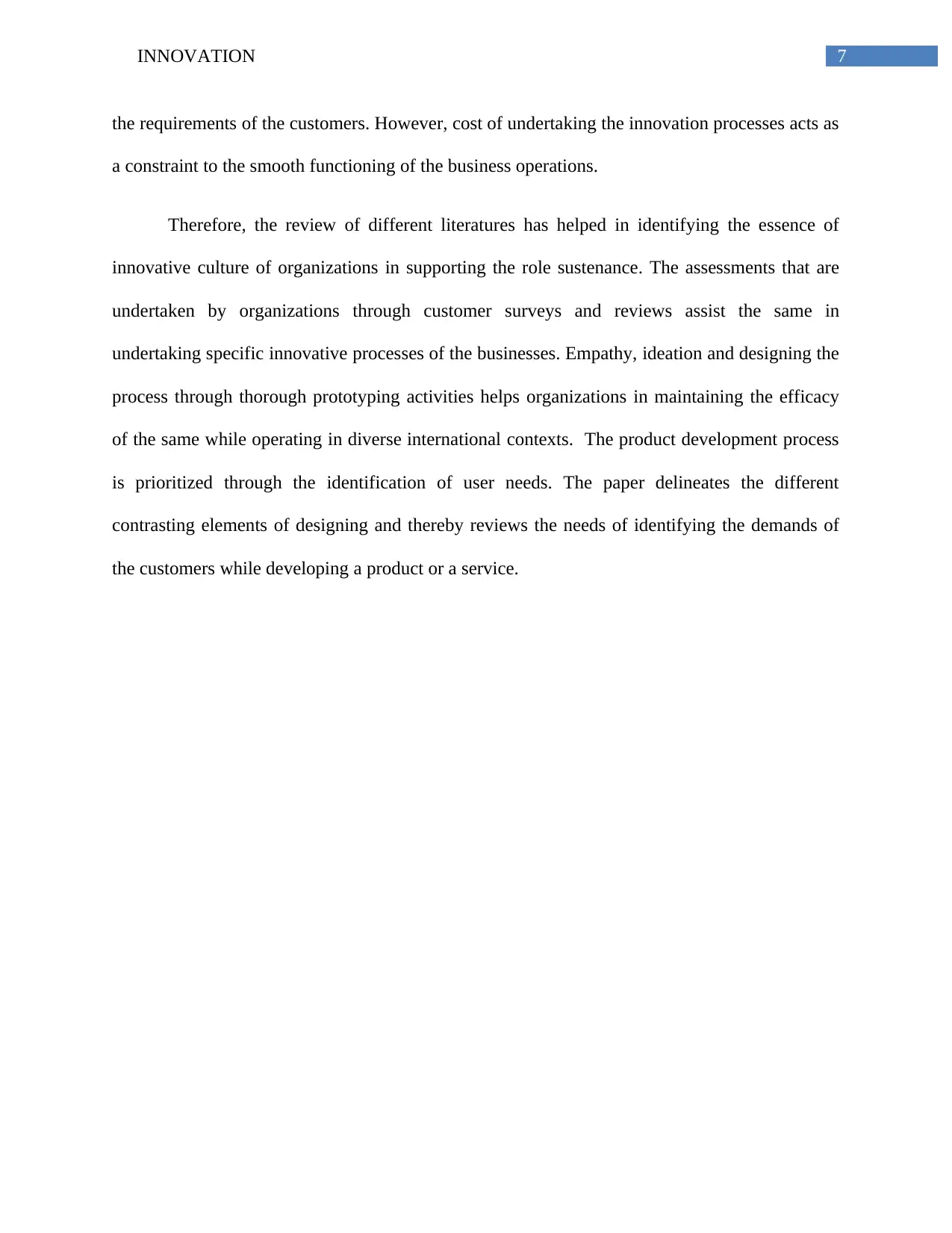
7INNOVATION
the requirements of the customers. However, cost of undertaking the innovation processes acts as
a constraint to the smooth functioning of the business operations.
Therefore, the review of different literatures has helped in identifying the essence of
innovative culture of organizations in supporting the role sustenance. The assessments that are
undertaken by organizations through customer surveys and reviews assist the same in
undertaking specific innovative processes of the businesses. Empathy, ideation and designing the
process through thorough prototyping activities helps organizations in maintaining the efficacy
of the same while operating in diverse international contexts. The product development process
is prioritized through the identification of user needs. The paper delineates the different
contrasting elements of designing and thereby reviews the needs of identifying the demands of
the customers while developing a product or a service.
the requirements of the customers. However, cost of undertaking the innovation processes acts as
a constraint to the smooth functioning of the business operations.
Therefore, the review of different literatures has helped in identifying the essence of
innovative culture of organizations in supporting the role sustenance. The assessments that are
undertaken by organizations through customer surveys and reviews assist the same in
undertaking specific innovative processes of the businesses. Empathy, ideation and designing the
process through thorough prototyping activities helps organizations in maintaining the efficacy
of the same while operating in diverse international contexts. The product development process
is prioritized through the identification of user needs. The paper delineates the different
contrasting elements of designing and thereby reviews the needs of identifying the demands of
the customers while developing a product or a service.
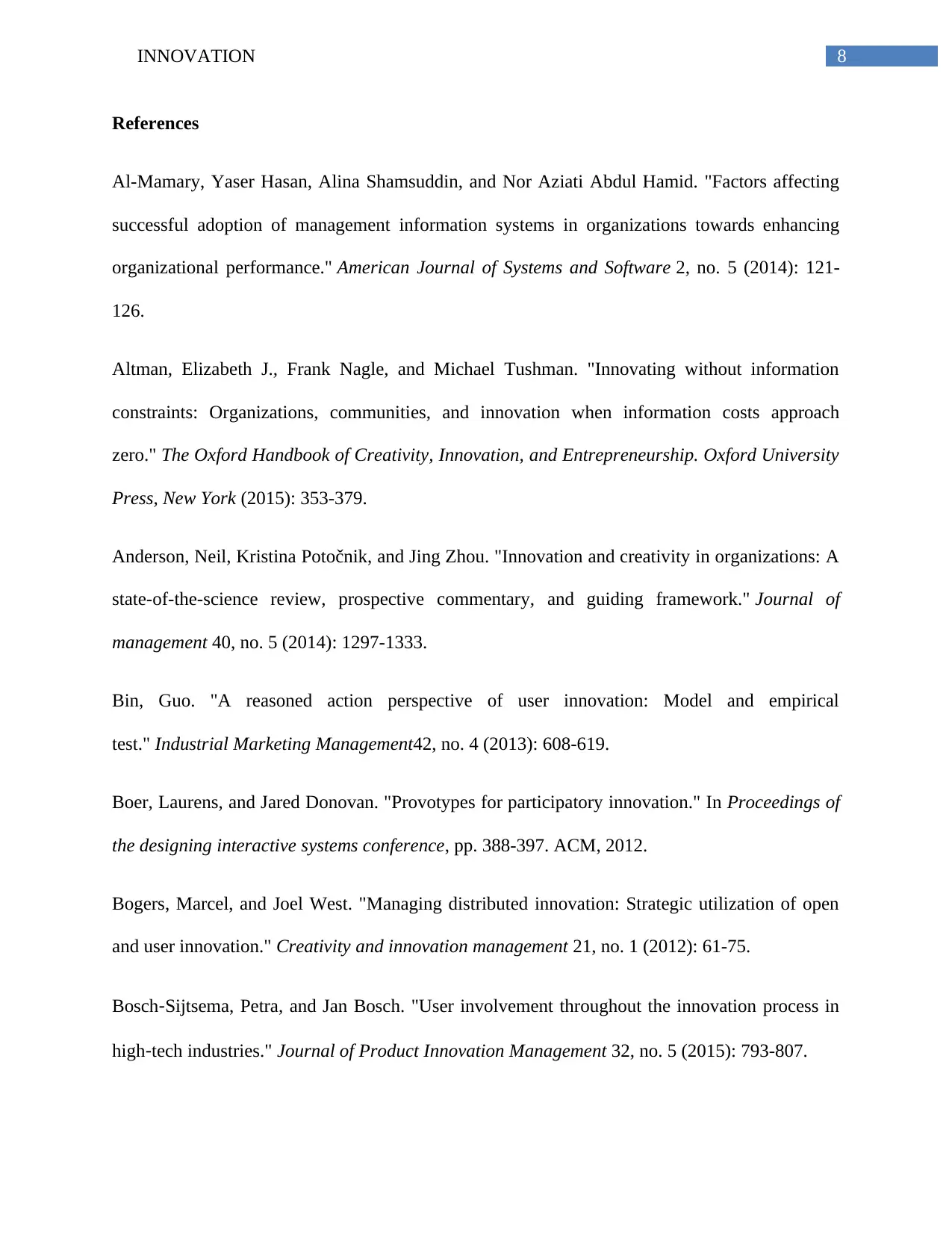
8INNOVATION
References
Al-Mamary, Yaser Hasan, Alina Shamsuddin, and Nor Aziati Abdul Hamid. "Factors affecting
successful adoption of management information systems in organizations towards enhancing
organizational performance." American Journal of Systems and Software 2, no. 5 (2014): 121-
126.
Altman, Elizabeth J., Frank Nagle, and Michael Tushman. "Innovating without information
constraints: Organizations, communities, and innovation when information costs approach
zero." The Oxford Handbook of Creativity, Innovation, and Entrepreneurship. Oxford University
Press, New York (2015): 353-379.
Anderson, Neil, Kristina Potočnik, and Jing Zhou. "Innovation and creativity in organizations: A
state-of-the-science review, prospective commentary, and guiding framework." Journal of
management 40, no. 5 (2014): 1297-1333.
Bin, Guo. "A reasoned action perspective of user innovation: Model and empirical
test." Industrial Marketing Management42, no. 4 (2013): 608-619.
Boer, Laurens, and Jared Donovan. "Provotypes for participatory innovation." In Proceedings of
the designing interactive systems conference, pp. 388-397. ACM, 2012.
Bogers, Marcel, and Joel West. "Managing distributed innovation: Strategic utilization of open
and user innovation." Creativity and innovation management 21, no. 1 (2012): 61-75.
Bosch‐Sijtsema, Petra, and Jan Bosch. "User involvement throughout the innovation process in
high‐tech industries." Journal of Product Innovation Management 32, no. 5 (2015): 793-807.
References
Al-Mamary, Yaser Hasan, Alina Shamsuddin, and Nor Aziati Abdul Hamid. "Factors affecting
successful adoption of management information systems in organizations towards enhancing
organizational performance." American Journal of Systems and Software 2, no. 5 (2014): 121-
126.
Altman, Elizabeth J., Frank Nagle, and Michael Tushman. "Innovating without information
constraints: Organizations, communities, and innovation when information costs approach
zero." The Oxford Handbook of Creativity, Innovation, and Entrepreneurship. Oxford University
Press, New York (2015): 353-379.
Anderson, Neil, Kristina Potočnik, and Jing Zhou. "Innovation and creativity in organizations: A
state-of-the-science review, prospective commentary, and guiding framework." Journal of
management 40, no. 5 (2014): 1297-1333.
Bin, Guo. "A reasoned action perspective of user innovation: Model and empirical
test." Industrial Marketing Management42, no. 4 (2013): 608-619.
Boer, Laurens, and Jared Donovan. "Provotypes for participatory innovation." In Proceedings of
the designing interactive systems conference, pp. 388-397. ACM, 2012.
Bogers, Marcel, and Joel West. "Managing distributed innovation: Strategic utilization of open
and user innovation." Creativity and innovation management 21, no. 1 (2012): 61-75.
Bosch‐Sijtsema, Petra, and Jan Bosch. "User involvement throughout the innovation process in
high‐tech industries." Journal of Product Innovation Management 32, no. 5 (2015): 793-807.
⊘ This is a preview!⊘
Do you want full access?
Subscribe today to unlock all pages.

Trusted by 1+ million students worldwide

9INNOVATION
Fuller, Johann, Julia Muller, Katja Hutter, Kurt Matzler, and Julia Hautz. "Virtual worlds as
collaborative innovation and knowledge platform." In System Science (HICSS), 2012 45th
Hawaii International Conference on, pp. 1003-1012. IEEE, 2012.
Hameed, Mumtaz Abdul, Steve Counsell, and Stephen Swift. "A conceptual model for the
process of IT innovation adoption in organizations." Journal of Engineering and Technology
Management 29, no. 3 (2012): 358-390.
Heikkinen, Maarit, and Hannamaija Määttä. "Design driven product innovation in enhancing
user experience oriented organisational culture in B-to-B organisations." In Design Management
Symposium (TIDMS), 2013 IEEE Tsinghua International, pp. 127-135. IEEE, 2013.
Hsieh, JJ Po-An, Arun Rai, Stacie Petter, and Ting Zhang. "Impact of user satisfaction with
mandated CRM use on employee service quality." MIS quarterly (2012): 1065-1080.
Kraft, Christian. "Innovating Around New Products and Users." In User Experience Innovation,
pp. 165-177. Apress, 2012.
Liedtka, Jeanne. "Perspective: Linking design thinking with innovation outcomes through
cognitive bias reduction." Journal of Product Innovation Management 32, no. 6 (2015): 925-938.
Liem, André, and Eric Brangier. "Innovation and design approaches within prospective
ergonomics." Work 41, no. Supplement 1 (2012): 5243-5250.
Norman, Donald A., and Roberto Verganti. "Incremental and radical innovation: Design research
vs. technology and meaning change." Design issues 30, no. 1 (2014): 78-96.
Fuller, Johann, Julia Muller, Katja Hutter, Kurt Matzler, and Julia Hautz. "Virtual worlds as
collaborative innovation and knowledge platform." In System Science (HICSS), 2012 45th
Hawaii International Conference on, pp. 1003-1012. IEEE, 2012.
Hameed, Mumtaz Abdul, Steve Counsell, and Stephen Swift. "A conceptual model for the
process of IT innovation adoption in organizations." Journal of Engineering and Technology
Management 29, no. 3 (2012): 358-390.
Heikkinen, Maarit, and Hannamaija Määttä. "Design driven product innovation in enhancing
user experience oriented organisational culture in B-to-B organisations." In Design Management
Symposium (TIDMS), 2013 IEEE Tsinghua International, pp. 127-135. IEEE, 2013.
Hsieh, JJ Po-An, Arun Rai, Stacie Petter, and Ting Zhang. "Impact of user satisfaction with
mandated CRM use on employee service quality." MIS quarterly (2012): 1065-1080.
Kraft, Christian. "Innovating Around New Products and Users." In User Experience Innovation,
pp. 165-177. Apress, 2012.
Liedtka, Jeanne. "Perspective: Linking design thinking with innovation outcomes through
cognitive bias reduction." Journal of Product Innovation Management 32, no. 6 (2015): 925-938.
Liem, André, and Eric Brangier. "Innovation and design approaches within prospective
ergonomics." Work 41, no. Supplement 1 (2012): 5243-5250.
Norman, Donald A., and Roberto Verganti. "Incremental and radical innovation: Design research
vs. technology and meaning change." Design issues 30, no. 1 (2014): 78-96.
Paraphrase This Document
Need a fresh take? Get an instant paraphrase of this document with our AI Paraphraser

10INNOVATION
Nylén, Daniel, and Jonny Holmström. "Digital innovation strategy: A framework for diagnosing
and improving digital product and service innovation." Business Horizons 58, no. 1 (2015): 57-
67.
Palacios-Marqués, Daniel, José M. Merigó, and Pedro Soto-Acosta. "Online social networks as
an enabler of innovation in organizations." Management Decision 53, no. 9 (2015): 1906-1920.
Seltzer, Ethan, and Dillon Mahmoudi. "Citizen participation, open innovation, and
crowdsourcing: Challenges and opportunities for planning." Journal of Planning Literature 28,
no. 1 (2013): 3-18.
Teixeira, Jorge, Lia Patrício, Nuno J. Nunes, Leonel Nóbrega, Raymond P. Fisk, and Larry
Constantine. "Customer experience modeling: from customer experience to service
design." Journal of Service Management 23, no. 3 (2012): 362-376.
Wooder, Stella, and Steven Baker. "Extracting key lessons in service innovation." Journal of
Product Innovation Management 29, no. 1 (2012): 13-20.
Yoo, Youngjin, Richard J. Boland Jr, Kalle Lyytinen, and Ann Majchrzak. "Organizing for
innovation in the digitized world." Organization science 23, no. 5 (2012): 1398-1408.
Nylén, Daniel, and Jonny Holmström. "Digital innovation strategy: A framework for diagnosing
and improving digital product and service innovation." Business Horizons 58, no. 1 (2015): 57-
67.
Palacios-Marqués, Daniel, José M. Merigó, and Pedro Soto-Acosta. "Online social networks as
an enabler of innovation in organizations." Management Decision 53, no. 9 (2015): 1906-1920.
Seltzer, Ethan, and Dillon Mahmoudi. "Citizen participation, open innovation, and
crowdsourcing: Challenges and opportunities for planning." Journal of Planning Literature 28,
no. 1 (2013): 3-18.
Teixeira, Jorge, Lia Patrício, Nuno J. Nunes, Leonel Nóbrega, Raymond P. Fisk, and Larry
Constantine. "Customer experience modeling: from customer experience to service
design." Journal of Service Management 23, no. 3 (2012): 362-376.
Wooder, Stella, and Steven Baker. "Extracting key lessons in service innovation." Journal of
Product Innovation Management 29, no. 1 (2012): 13-20.
Yoo, Youngjin, Richard J. Boland Jr, Kalle Lyytinen, and Ann Majchrzak. "Organizing for
innovation in the digitized world." Organization science 23, no. 5 (2012): 1398-1408.
1 out of 11
Related Documents
Your All-in-One AI-Powered Toolkit for Academic Success.
+13062052269
info@desklib.com
Available 24*7 on WhatsApp / Email
![[object Object]](/_next/static/media/star-bottom.7253800d.svg)
Unlock your academic potential
Copyright © 2020–2025 A2Z Services. All Rights Reserved. Developed and managed by ZUCOL.




